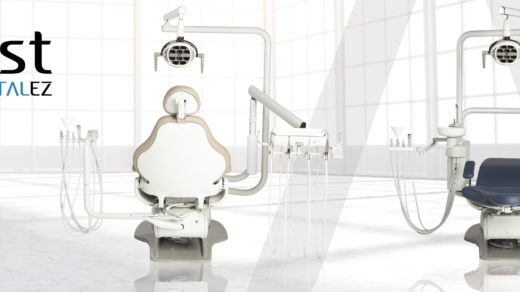The DENTALEZ name has been an industry standard for over 100 years. Over that time, we’ve remained steadfast in our quality, and innovative in our approach to solving everyday problems in dentistry.
We started by a walk through the history of our Star family of handpieces, and the various innovations that have led to them leading the industry for decades. Next, we focused on our customizable Forest line of dental equipment —patient chairs and accessories —and how those have changed in response to or in anticipation of needs in our market.
This month, we’re looking back to share the interesting evolution and surprising origins of our steadfast utility line.
We spoke with some of our longest-standing DENTALEZ employees, for an informal and informative storytelling that made it clear this product line has long been a family affair. Jeff Flesner, Tech Service Representative, led the history download, as he’s been with DENTALEZ for 18 years and worked with the Ramvac vacuum innovator Dr. Bob Meyer himself in the early 1970s! We also got great anecdotes from Marion Alderman, Customer Experience Manager, who has great memories of the early collaboration DENTALEZ is grounded in. Bill Paulson, Technical Service Manager, added the experience and perspective of his 40-plus years with DENTALEZ, and Beth Jones, current DENTALEZ Senior Product Manager, Utility, chimed in with her observations from today’s customer perspective.
Jeff, tell us how you met Dr. Bob and how the Ramvac Vacuum pump story started…
This starts with an Air Force officer by the name of Bob Meyer. He was stationed out here (here being Spearfish, South Dakota), and liked the area, so when he left the Air Force, he went to dental school in Lincoln, Nebraska, then moved back to the area to practice.
Bob is also a tinkerer. He didn’t like the existing vacuum system—he felt the use of water was wasteful, and that the suction the existing vacuum had wasn’t sufficient. While he’s doing the dental work, he also sets about creating a better vacuum. That’s how I first met him—he came into the auto parts store I was working in, in the 70s, looking for parts. The first vacuum he built, in 1972, is still down the street, functioning in his old office!
Bob practiced dentistry for about 13 years, and then he left the office to focus on the vacuum systems. He kept redesigning and improving them. He eventually expanded out of his garage, into a bigger building, and just continued to grow. As he expanded, he ultimately sold to DENTALEZ. Eventually, production shifted to Alabama, but we’re still here as customer and tech service, because of course now you can do things remotely, so we were able to remain where we live.
Bill Paulson, (Technical Service Manager), interjects: Wait, you forgot to mention the fact that Doctor Bob would actually demonstrate the strength of the vacuum by lifting a bowling ball!
Yeah—when Dr. Bob first started going to dental shows, he would set up his space so he could run the vacuum during the show. Bob created this manifold suction device with several hose extensions, and while he was talking with the doctors and sales guys, he would just take this contraption, grab a bowling ball–pick it right up–and hold it right there! And he’d just keep talking, casually, all the while, then he would start opening up suction devices which take vacuum away from the machine, and eventually release the bowling ball. It was an incredible visual–really powerful.
Sounds like Dr. Bob was quite a character! What drove the various tweaks and changes Dr. Bob was making?
Marian (Customer Experience Manager), answers:
It was always about answering the needs of the dentists. It was a really small company when I first came on board; I was employee number nine! We had this great tradition of gathering around the table at break time every day, around 9:30 or 10:00 o’clock, and we’d talk about the things we were hearing in the industry and among our customers and just brainstorm about what we could do about it. That went on for many years. We’d just ask ourselves, what else can we do, to make it more efficient, safer, more reliable…? We’d have all the experts in the –room—customer service, manufacturing, sales, management.
We’d run with any idea. At one point, when tanks used to be made of fiberglass, they would get damaged during transit. One of the things we did was try to see how much impact the tank could take before that happened. I’ll never forget that–the whole company stood and watched, while we dropped a tank off the roof of our building, to test its limits! That’s how we came up with the idea for using rotomolded tanks, which were made of plastic. The plastic significantly reduced the damage that happened during transit.
In terms of other innovations and improvements, what else came out of those coffee break sessions?
Bob, being from the military, had a lot of military connections, and through his conversations, he’d learn about their needs. At some point he understood that they needed to be able to run large systems more efficiently—and it wasn’t just about having enough vacuum to run a large military complex. One of his early innovations was the MPC, which was an early computer board that we could connect a number of units to. That helped automate what had previously been manual. Hours could be tracked, machines could be run on a specific schedule and cycled, and alarms would set off if things went awry. That was very attractive to the military, and one of our very first big sales was to the Pentagon, in the late 90s.
Getting into bigger clinics like the ones in the military led to additional innovation, because once you get in there, they have really interesting, designer requests. You listen to all of that feedback, help them figure out what they need, design it, and make it work.
Of course, we never lost sight of what was working; we never messed around with anything that would change or risk the dependability and power of the vacuum. We weren’t there to re-create or redesign a perfectly good wheel. Just add things to it to make the whole operation better.
Were there also external forces to adjust to? How did the industry change and how did that guide the decisions that you (meaning you, Bob, the team, DENTALEZ) made, with reference to the changes that you then made to the equipment?
When we created a version of RAMVAC that utilized a dry system, we definitely became aware that a contingent of our dentists liked the cost savings, and the “greening” aspect of a system that didn’t use all that water. Water is of course a precious resource, and not using it lowers operating costs. A wet system can be very expensive because you pay a sewer bill based on your water consumption, then you also pay for the disposal of that water. A pump that’s going through a half a gallon of water a minute or even a gallon of water a minute, over eight hours a day, adds up to a lot of water. Dry vacuums don’t use water, so they’re more economical.

I would say that the smaller design was driven by external forces like the increasing cost of square footage in a dental practice. We designed the vacuum pump to still be very strong, but only take up a certain amount of space in the mechanical room.
The nature of the work also drove innovation—as procedures drove the need for not only removing liquid and solid waste from the oral cavity with some of the machines, but also putting clean dry air back in place, we’re looking at a whole new set of required rules and enhanced safety features. The dual desiccant system was borne out of this. We’re able to provide medical-grade air that’s dry and clean, for the safety of patients, and dentists and their staff.
And there’s efficiency built in, as well–instead of needing a new dryer, in a shorter amount of time, you simply replace a set of cartridges for the current dryer. It’s a lot more affordable to do maintenance on the machine, rather than replace the whole system. Cost is always a priority for us; we are always aware of keeping costs down for our customers.
And from the customer’s perspective, what do you hear from our customers in terms of what they think and say about Ramvac? How would they say it’s changed over time, and what are they asking for, next?
You know, we just kind of pay attention to what the doctors are talking about, in the field and especially at shows and that drives the wish list. A lot of the changes to-date were customer-driven, in exactly that way, like the MPC (Micro Processor Control) system.
I’d say right now, technology is the number one thing we’re integrating into our thinking and innovation. Using the cloud, utilizing apps, making things accessible from cell phones, that’s what people expect these days.
How does Aeras play a role in this new environment?
It allows us to look at the maintenance information with consistent monitoring and insight; the embedded sensors pinpoint exactly what’s wrong, so service is much more efficient than in the days of guessing in a crowded utility room! We don’t even physically have to go in and monitor the dental offices—it’s all done remotely thanks to technology.
We’re also able to keep a history on each piece of equipment we sell. That helps us identify the root cause of any potential problem even faster and make targeted fixes. And in many cases, this saves everyone time, money, and headaches! It lets our customer experience folks provide superior service and helps set us apart in the industry. It also helps our dealer techs provide exceptional service.
The significance of being able to anticipate problems before they become issues that might bring an office down for hours at a time can’t be overstated. It’s also going to help us see data over time that will help us make the next round of innovative improvements!
And what would you say is the most significant change in the industry right now that DENTALEZ is responding to in terms of innovation? Beth and Bill shared their thoughts in response…
On the one hand, we have less access to individual doctors; we’re doing more through email versus phone calls. That means we don’t see in person what the dentists are dealing with everyday so being responsive to their needs takes a different approach.
They are more focused on doing what they went to school for, and hiring someone to work on their equipment, versus dealing with it themselves. Ease of use and reliability are still critical but it’s almost like it’s outsourced, and instead of interacting with the dentist about equipment, we’re working on installation and maintenance with other staff, or the dealer.
We’re also seeing much more movement away from the single practice private practice doctor to the DSOs. That only reinforces the outsourcing of equipment purchasing and servicing, and investment strategy has changed alongside that evolution too; the practice owners now have investors to make happy. A bigger staff of dentists who come and go more often leads to a different sense of connection to the equipment. It also requires a serious workhorse in that equipment, with power, flexibility, and noise control.
And we’re seeing consolidation across the dealers, too. The number of dealers in the industry shrank dramatically in the 90s and 2000s. I mean it felt like every time we turned around there was another dealer that had been bought up by somebody else. That changed the environment we were working in, too.
We would like to thank the Utility team for sharing their time, and their stories. We are excited to see what comes next!


